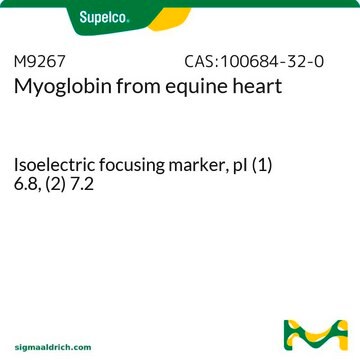O7252
橙黄 G
Dye content, ≥80%, certified by the Biological Stain Commission, powder
别名:
1-苯基偶氮基-2-萘酚-6,8-二磺酸 二钠盐, 7-羟基-8-苯基偶氮基-1,3-萘二磺酸 二钠盐, Wool Orange 2G, 酸性橙 10
登录查看公司和协议定价
所有图片(3)
About This Item
经验公式(希尔记法):
C16H10N2Na2O7S2
CAS号:
分子量:
452.37
颜色索引号:
16230
Beilstein:
4120705
EC 号:
MDL编号:
UNSPSC代码:
12171500
PubChem化学物质编号:
NACRES:
NA.47
推荐产品
产品名称
橙黄 G, certified by the BSC
Agency
certified by the BSC
表单
powder
组成
Dye content, ≥80%
技术
microbe id | staining: suitable
颜色
orange to very dark orange
溶解性
water: 1 mg/mL, clear
应用
diagnostic assay manufacturing
hematology
histology
储存温度
room temp
SMILES字符串
[Na+].[Na+].Oc1ccc2cc(cc(c2c1\N=N\c3ccccc3)S([O-])(=O)=O)S([O-])(=O)=O
InChI
1S/C16H12N2O7S2.2Na/c19-13-7-6-10-8-12(26(20,21)22)9-14(27(23,24)25)15(10)16(13)18-17-11-4-2-1-3-5-11;;/h1-9,19H,(H,20,21,22)(H,23,24,25);;/q;2*+1/p-2/b18-17+;;
InChI key
HSXUHWZMNJHFRV-QIKYXUGXSA-L
正在寻找类似产品? 访问 产品对比指南
相关类别
一般描述
橙黄G(C.l.16230)是苯偶氮-2-萘酚-6,8-二磺酸的二钠盐,分子式为C16H10N2O7S2Na2。橙黄G(Orange G),别名wool orange 2G(金橙G,桔黄G等),广泛用于细胞学、组织学、生物学和工业染色。它是Mallory结缔组织染色剂的组分之一。
应用
橙黄G常用作各种生物学样本的背景或细胞质染色剂,包括常见的采用巴氏改良染色法的临床细胞学应用。
适用性
认证用于 Mallorys 结缔组织染色;Wilson-Ezrin 法检测垂体嗜酸细胞;角蛋白和粘液的克雷伯格法;作为石蜡切片上 Heidenhain 铁苏木精之后的复染剂;洋葱根上的石蜡切片Flemming三重染色。
储存分类代码
11 - Combustible Solids
WGK
WGK 3
闪点(°F)
Not applicable
闪点(°C)
Not applicable
个人防护装备
Eyeshields, Gloves, type N95 (US)
历史批次信息供参考:
分析证书(COA)
Lot/Batch Number
其他客户在看
Integrity of chromatin and replicating DNA in nuclei released from fission yeast by semi-automated grinding in liquid nitrogen.
Givens RM
BMC Research Notes, 4, 499-499 (2011)
Arumugam Sivasamy et al.
Current microbiology, 62(2), 351-357 (2010-07-21)
Biosorption is an eco-friendly and cost-effective method for treating the dye house effluents. Aspergillus niger and Trichoderma sp. were cultivated in bulk and biomasses used as biosorbents for the biosorption of an azo dye Orange G. Batch biosorption studies were
M Arulkumar et al.
Journal of hazardous materials, 186(1), 827-834 (2011-01-15)
Thespesia populnea is a large tree found in the tropical regions and coastal forests of India. Its pods were used as a raw material for the preparation of activated carbon. The prepared activated carbon was used for the adsorptive removal
G Thennarasu et al.
Environmental science and pollution research international, 19(7), 2755-2765 (2012-02-23)
The photocatalytic degradation of Orange G (OG) dye has been investigated using synthesised nanocrystalline ZnO as a photocatalyst and sunlight as the irradiation source. The formation of ZnO prepared from its precursor was confirmed through FT-IR and powder X-ray diffraction
A R Khataee et al.
Journal of hazardous materials, 168(1), 451-457 (2009-03-13)
In order to discuss the effect of chemical structure on photocatalysis efficiency, the photocatalytic degradation of three commercial textile dyes (C.I. Acid Orange 10 (AO10), C.I. Acid Orange 12 (AO12) and C.I. Acid Orange 8 (AO8)) with different structure and
我们的科学家团队拥有各种研究领域经验,包括生命科学、材料科学、化学合成、色谱、分析及许多其他领域.
联系客户支持









